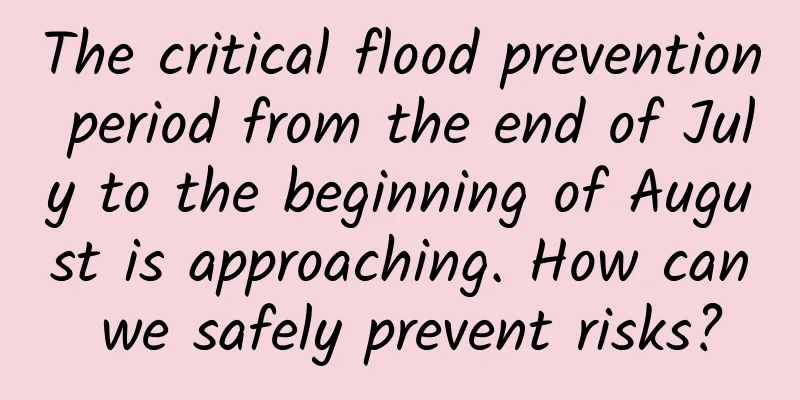The critical flood prevention period from the end of July to the beginning of August is approaching. How can we safely prevent risks?

|
China has fully entered the main flood season and is about to usher in the critical flood prevention period of "the end of July and the beginning of August" . According to forecasts and analysis, during this critical flood prevention period, China's climate conditions will be generally abnormal, with more extreme weather and climate events, more rainfall in the eastern region, and more obvious regional and periodic flood disasters. The flood situation report released by the Ministry of Water Resources shows that according to the forecast, my country has entered the critical flood prevention period of "the end of July and the beginning of August". Drought and floods will occur simultaneously, and floods will be more serious than drought. Extreme emergencies such as rainstorms and floods will become more frequent, wider, stronger, and have serious impacts. The upper reaches of the Yangtze River, the middle and lower reaches of the Yellow River, the Yi River and Shuhe River in the Huaihe River Basin, the Zhangwei River and Ziya River in the Haihe River Basin, the Songhua River, and the Liaohe River may have severe flood conditions. There may be 2 to 3 typhoons making landfall, which is close to the annual average to more than usual, and the intensity is strong. There is a possibility that a typhoon will move north and cause disasters. A must-read during the flood season! A guide to avoiding risks and saving yourself During the critical flood prevention period, early evacuation is an important part of disaster prevention and mitigation . In addition to paying close attention to the rainfall and flood warning information issued by the meteorological department through mobile phones, television, radio and other channels, it is also necessary to keep abreast of the rainfall and river water levels in your area and upstream and downstream so as to respond in a timely manner. Prepare emergency supplies in advance Daily necessities: Stock up on sufficient food, drinking water, clothing, medicine, and emergency items such as flashlights, whistles, raincoats, etc. Communication equipment: Make sure that mobile phones, power banks and other communication equipment are sufficiently charged so that you can contact the outside world in an emergency. Develop a risk-avoidance plan Family plan: Family members should jointly develop a transfer and evacuation plan, clearly defining the gathering place, evacuation route and contact information. High-risk areas: People living in high-risk areas such as low-lying areas, river banks, and mountainous areas should be moved to safe areas in advance. If you need to evacuate on foot, try to avoid flooded areas and take shelter in high ground or sturdy buildings. Avoid touching objects that may conduct electricity, such as electric poles and trees, to prevent electric shock. Comply with government directives Obey orders: Once you receive an order from the government to evacuate or move to a safe place, you should act immediately without delay. Orderly evacuation: Evacuate in an orderly manner according to the designated evacuation routes and assembly points to avoid causing chaos and congestion. Pay attention to secondary disasters Landslides and mudslides : Rainfall can easily trigger landslides and mudslides. People living in mountainous areas or surrounding areas should be particularly vigilant, pay close attention to changes in the mountains, and evacuate immediately if any abnormalities are found. Urban waterlogging : Urban waterlogging is also one of the common secondary disasters. Residents living in low-lying areas or areas with poor drainage should take preventive measures in advance. If you encounter heavy rain while driving, try to avoid driving. If you must travel, pay attention to road conditions and avoid wading to prevent your vehicle from being flooded. Improve disaster prevention and risk avoidance awareness and self-rescue and mutual rescue capabilities Be the first person responsible for the safety of yourself and your family Comprehensive sources: Xinhua News Agency, Ministry of Emergency Management, etc. |
<<: Plague warning! Catching pikas and touching groundhogs, is that a risk to your life?
>>: Nature sub-journal: Subverting cognition! Do we really need to be "brainwashed"?
Recommend
The efficacy and function of Castanopsis leaves
Traditional Chinese medicine culture is profound ...
Will drinking ice water often hurt your stomach? Will drinking hot water be fine?
Reviewer of this article: Chen Haixu, Deputy Dire...
The efficacy and function of black soybean flower
Black soybean flower is a medicinal material that...
What happens when a black hole passes close to the Earth?
Imagine if there is a celestial body whose gravit...
The History of Vaccines: Technologies, Diseases, and Challenges
In Kabul, the capital of Afghanistan, health work...
What Chinese medicine should I take for spleen deficiency and constipation?
The spleen is also an important organ among the h...
The efficacy and function of Daquan hemp
The essence of traditional Chinese medicine is to...
You can stand guard and take care of babies. It turns out you are this kind of mongoose!
Do you still remember this photo? In the previous...
The efficacy and function of civet
The Chinese herbal medicine civet is a relatively...
What are the medicinal values of Ganoderma lucidum
Ganoderma lucidum has very high medicinal value. ...
√2 caused a stir in the mathematical world, and some people even sacrificed their lives for it...
I wonder if you have ever thought seriously about...
The efficacy and function of wild spicy tobacco
Wild tobacco is a common Chinese medicine in clin...
This is the first time I heard that the stars can be observed during the day! On the 27th, let's enjoy the fairy tale of the stars and the moon together
Original title: A "starry fairy tale" d...
What is the best thing to stew with Cordyceps
There are many kinds of nutritious soups we consu...
The efficacy and function of Rhizoma Coptis Chinensis
Coptis chinensis is a medicinal material. If we h...









